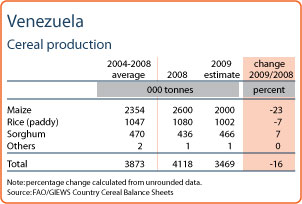Venezuela: Venezuela Agriculture Profile 2012
2012/04/06
Venezuela Agriculture Profile 2012
Reference Date: 10-June-2011
|
FOOD SECURITY SNAPSHOT
|
Sowing of 2011 maize affected by rainfall
Above average rainfall in April and May have delayed the sowing of the 2011 maize crop and led to losses of crops that were sown early. The most affected areas are the states of Portuguesa, Táchira, Cojedes and Barinas where substantial reductions in the area sown for this season are expected. Heavy rainfall is also affecting vegetable yields.
Recovery in rice yield predicted for 2011
The 2011 rice crops are currently being sown. The early outlook is favourable due to heavy rainfall and to government measures to support production after the reduced yields produced last year as a result of a prolonged drought and floods. Official forecasts indicate that production could increase by up to one-third if weather conditions remain normal throughout the main agricultural season of 2011.
06/12/2010 Following a prolonged drought, recent torrential rains have caused some damage in the Caribbean coastal areas
 Since the end of September and throughout the month of October, heavy precipitation was recorded throughout the country, particularly in the Caribbean coastal areas. The heavy rainfall has caused landslides and flooding. This intense rainfall followed a severe and prolonged drought which has persisted since December 2009 and has also affected the important farming state of Guarico. Caracas, the capital city, has also been affected by the torrential rains causing damages. The National Assembly has approved a further mobilization of funds of VEF 250 000 000, equivalent to almost USD 60 million for reconstruction.
Since the end of September and throughout the month of October, heavy precipitation was recorded throughout the country, particularly in the Caribbean coastal areas. The heavy rainfall has caused landslides and flooding. This intense rainfall followed a severe and prolonged drought which has persisted since December 2009 and has also affected the important farming state of Guarico. Caracas, the capital city, has also been affected by the torrential rains causing damages. The National Assembly has approved a further mobilization of funds of VEF 250 000 000, equivalent to almost USD 60 million for reconstruction.
Harvesting of the main maize crop is underway; estimates indicate a decline
 Harvesting of the main winter maize and secondary rice crops is well advanced. Preliminary forecasts point to a significantly reduced maize output, about 23 percent compared to the previous year and 15 percent compared to the previous five years average. This is mainly due to the severe drought conditions that affected the main producing states at the beginning of the cropping season. In addition, the nationwide measures for rationing of power, following lack of water for the hydropower plants is also having an overall negative impact on the entire agricultural sector.
Harvesting of the main winter maize and secondary rice crops is well advanced. Preliminary forecasts point to a significantly reduced maize output, about 23 percent compared to the previous year and 15 percent compared to the previous five years average. This is mainly due to the severe drought conditions that affected the main producing states at the beginning of the cropping season. In addition, the nationwide measures for rationing of power, following lack of water for the hydropower plants is also having an overall negative impact on the entire agricultural sector.
The secondary season paddy harvesting is currently underway, The overall 2010 paddy production, estimated at about one million tonnes, is about 7 percent below the previous year.
Producers demand higher prices for their crop to sustain rising production costs
Despite a slight rise in producer’s prices for paddy rice and maize, fixed at VEF1,56/Kg and VEF1,15/Kg, farmers still contend that this rise is not sufficient to compensate for the increase in production costs.
Non oil export revenue continued to contract by 9 percent year on year to USD 775m in comparison to levels approaching USD 2bn in the early 2000s. In contrast the total export earnings rose by 10 percent year on year, which has been attributable to higher oil prices that have lifted oil export revenue by 11 percent, to USD15.3bn.
Agriculture is the weakest sector of the economy of Venezuela, and large quantities of food must be imported. Problems have included agricultural practices and lack of modern equipment. Since about 1960, the government has undertaken numerous programs to try year to make the nation self-sufficiency and improved living standards in rural areas. Thesis measures including land reform and the completion of extensive irrigation and reclamation projects.
Most farms Is Done in gold near the northern mountains, where according to altitude crops, tropical and temperate crops are many. Agricultural lands in the Llanos is devoted primarily to livestock, although some areas are open to agriculture. major food crops are maize, rice, beans, cassava, sweet potatoes, yams, potatoes and white. Coffee and cocoa are the major export crops. Other agricultural products include sugarcane, bananas, tobacco, oranges, and cotton.
The commercial fishing industry is a "significant and increasingly important. Sardines, tuna, herring, red snapper and shellfish are the most catches.
- Related Articles
-
东帝汶农业概况
2012/08/27 更多
-
- Venezuela News
-
- VENEZUELA: State of emergency declared in Venezuela to counter "US and domestic threats"
- VENEZUELA: Venezuela's socialists threaten opposition's landmark majority
- VENEZUELA: Opposition ends decades of socialist rule in Venezuela
- AFGHANISTAN: Global growth will be disappointing in 2016: IMF's Lagarde
- VENEZUELA: Assessing Venezuela’s Elections: The Good, the Bad, and the Indifferent
- GUYANA: Mexico ready to purchase Guyana rice following Venezuela's refusal to renew exchange accord
- Trending Articles
-
- PHILIPPINES: Will services continue to drive the Philippine economy?
- AZERBAIJAN: EU to realize new twinning projects in Azerbaijan
- UNITED STATES: My Diplomatic Moment with Mohammed Ali
- ALGERIA: Algeria looks to boost capital markets liquidity
- CHINA: Djibouti partners with China to develop local infrastructure and global trade routes
- CHINA: United States sees China investment talks ‘productive’ after new offers







